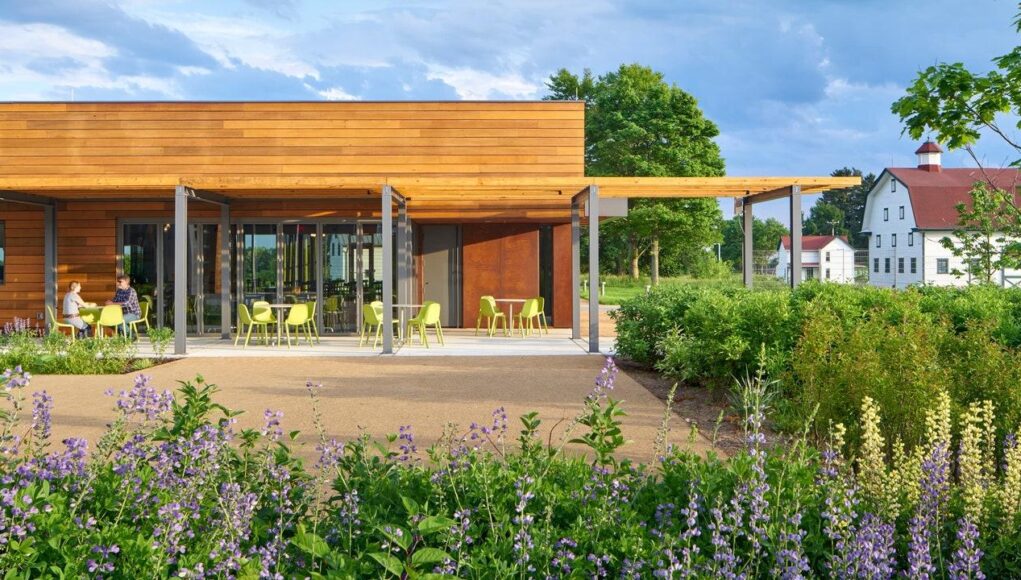It’s undeniable that landscape architects add immeasurable value to any building project—bringing their deep knowledge of everything from soil conditions and native plant species to environmental patterns, agriculture, renewable energy, and so much more. And as extreme weather worsens, good landscape design and management is becoming even more imperative for our health, and the Earth’s too. So it comes as little surprise that the US Department of Homeland Security recently designated landscape architecture as a STEM discipline, recognizing the high degree of science, technology, engineering, and mathematics inherent in the education and practice of landscape architecture, and marking a important leap away from “the impression that landscape architects only select plants,” says Debra Guenther, partner at Seattle-based firm Mithun.
“It’s an indication of the growing understanding of the importance of landscape architecture and its cultural, social, and environmental contributions,” adds Michelle Delk, partner and landscape architecture discipline director at Snøhetta. This designation not only opens up new research and funding opportunities, but also has important implications for international students after they graduate. (For a deeper dive, this white paper released by the American Society of Landscape Architects is very comprehensive.) Looking ahead, this may well mean that young people will choose to study landscape architecture over other design fields, as it may create an easier path into the industry, and offer a better chance of staying in the US post-graduation.
“Design fields in general have also struggled to attract BIPOC members and first-generation college students who bring critical experience and perspective for making design relevant to broadening audiences,” remarks Guenther. “Surveys have indicated that families are often evaluating the return on investment in education, and a STEM designation can help alleviate the impressions around those concerns.”
With a likely influx of qualified landscape architects into the job market, and a demand for these professionals increasing, what does this mean for architecture and interior firms? Is now the time to consider hiring landscape architects as full-time team members, rather than outsourcing their services from separate companies? This approach certainly has its benefits, according to studios like Marmol Radziner, which adopted the practice long ago. “With our architects and landscape architects under one roof, we can integrate the landscape with the architectural design from the beginning, to allow the building and site to become an expression of a singular vision,” says partner Ron Radziner, who began putting landscape architects on the payroll 25 years ago, and typically employs between 7 and 10 specialists at any given time. It’s a natural synergy, since “we’re often thinking about the design for the garden while we’re thinking about the design of the house,” he adds.
Close collaboration between architects and landscape architects is always critical to a project’s overall success, and when cross-discipline conversations can happen daily in meeting rooms or by the water cooler, this only increases the chances of a well-integrated outcome. “By having landscape architects as a constant part of the design conversation, from the beginning of projects and through casual discourse, the culture and the design work coming from Mithun has shifted to regularly centering the nuances of place, ecology, human comfort from a nature-based and science perspective,” says Guenther, whose team includes 22 landscape architects.
Similarly, Rios founder Mark Rios (who is formally trained in both fields) has incorporated landscape architects into his practice since day one. The firm operates the largest landscape architecture studio on the West Coast, and also has outdoor studios in its international offices in Singapore, Shanghai, and London. “Landscape architecture is such a critical component to our business and our everyday practice,” Rios explains. “That inherently brings value to the design process, and delivers places and spaces that are accessible, exuberant, multisensory, and dynamic.”
Clients, he adds, like the idea that the project will be completed by a single team, so that they don’t have to deal with multiple voices from different studios. Radziner agrees: “There have been clients who have hired us, at least in part because they have appreciated the integration of both architecture and landscape architecture in the firm.”
However, it’s not quite as simple as hiring several landscape architects, and leaving them to get on with the job. Some may not have worked in multidisciplinary offices before, and require extra training to understand the unique processes this set-up entails. Some may also decide to shift their focus to architecture or interiors once they’ve had a taste of these disciplines, leaving you back where you started. “Maintaining an integrated design culture is a continuous learning experience,” Guenther says. “It’s not a one-and-done initiative. It takes intention and vigilance to adapt to those signals and stay focused on the value of integrated design.”
Firms also need to ensure that landscape-trained colleagues are seen as equals bringing just as much to the table as architects and interior architects, to ensure smooth and successful collaboration. “When the hierarchy that is so often present between the disciplines is set aside, there’s potential to impact our world in a powerful way,” Delk says. “Make no mistake, this is not easy,” she adds, though insists it’s wholly worth the effort.
The benefits to bringing landscape architects in-house appear to well outweigh the challenges. All of the firms we spoke to had nothing but positive things to say about their experiences of having a diverse set of skills, training, and opinions to contribute to their teams. Hiring full-time landscape architects will help to eventually “erase the distinction between buildings and landscape,” says Delk, and to “bring the wonder of nature deeper into everyday experience,” says Rios. Perhaps most importantly, Guenther adds: “In the urgency to address climate change, this can have a huge impact on the built environment. The future is as much about unbuilding places as it is about building them!” So, what are you waiting for?








